
Exwick - photos of a village
Page updated 19th January 2015
The first of hopefully several local pages for the different areas of Exeter. If you have a photo that would be suitable for inclusion on the page, or know more about one of the photographs, please email me. Jointly produced with the Exwick Local History Group. The Group is a loose association of members that exist to research, record and disseminate the history of Exwick through occasional talks, walks and displays of photographs and other artefacts for the public. Contact me if you would like to know more about the group.
Back to Photo Essays

 The photo of the interior of the church was taken to show it dressed for the marriage of Frank and Clara Kelland on the 13th April 1936. The couple lived in Ewhurst Villa in Exwick Road. In 1986, Frank found fame when he broke the world record for growing a sunflower at his house - the plant reached 23 ft 6.5 inch (7.17 metres). The couple had 2 children, 5 grand-children and 7 great grand-children. Clara celebrated her 100th birthday in November 2009 when she received 99 cards plus one from the Queen. She died in December 2010 aged 101.
The photo of the interior of the church was taken to show it dressed for the marriage of Frank and Clara Kelland on the 13th April 1936. The couple lived in Ewhurst Villa in Exwick Road. In 1986, Frank found fame when he broke the world record for growing a sunflower at his house - the plant reached 23 ft 6.5 inch (7.17 metres). The couple had 2 children, 5 grand-children and 7 great grand-children. Clara celebrated her 100th birthday in November 2009 when she received 99 cards plus one from the Queen. She died in December 2010 aged 101.

 This Cedar of Lebanon in Station Road (left) grows in St Andrews Churchyard. Thought to have been planted in 1870 when the church was extended, the branches have spread across the road over the years and become a danger to traffic. In July 2010, an appeal was made by Roy Hurford, the church warden, for funds to pay for it to be pruned, which was estimated to be £2,000. Councillor Rob Hannaford awarded a grant towards the work from his delegated budget. A further £50 was donated by a couple who had married in the church. On 24th January 2011, Dartmoor Tree Surgeons Ltd partly closed the road and removed the dangerous branches (right).
This Cedar of Lebanon in Station Road (left) grows in St Andrews Churchyard. Thought to have been planted in 1870 when the church was extended, the branches have spread across the road over the years and become a danger to traffic. In July 2010, an appeal was made by Roy Hurford, the church warden, for funds to pay for it to be pruned, which was estimated to be £2,000. Councillor Rob Hannaford awarded a grant towards the work from his delegated budget. A further £50 was donated by a couple who had married in the church. On 24th January 2011, Dartmoor Tree Surgeons Ltd partly closed the road and removed the dangerous branches (right).
 NEW Lamb Inn outing 1965. The customers of the Lamb Inn line up for a photo before embarking on a day trip to some exotic Devon destination. Photo courtesy of Yvonne Small.
NEW Lamb Inn outing 1965. The customers of the Lamb Inn line up for a photo before embarking on a day trip to some exotic Devon destination. Photo courtesy of Yvonne Small.
 NEW This view of Exwick from about 1925 shows the heart of the village. The war memorial is relatively new, while the Steam Laundry to the rear is, with the Exwick Mill, the largest employer in the village. The Lamb Inn was also at the centre of the community.
NEW This view of Exwick from about 1925 shows the heart of the village. The war memorial is relatively new, while the Steam Laundry to the rear is, with the Exwick Mill, the largest employer in the village. The Lamb Inn was also at the centre of the community.

 This photograph
was found
in a very faded condition in the church. The
front mount had been removed and there was no glass. It is an original
albumen print, originally thought to be the celebration of the
Coronation in 1902. Further research revealed it to be the leaving
party for the vicar Rev. L. P. Williams-Freeman MA in 1912. He was
appointed as the fourth vicar of the village in 1897. The event is
being held in the garden of the vicarage, and Exwick School can be seen
on the other side of the wall. Many are wearing rosettes while some
just simple ribbons on their lapels.
This photograph
was found
in a very faded condition in the church. The
front mount had been removed and there was no glass. It is an original
albumen print, originally thought to be the celebration of the
Coronation in 1902. Further research revealed it to be the leaving
party for the vicar Rev. L. P. Williams-Freeman MA in 1912. He was
appointed as the fourth vicar of the village in 1897. The event is
being held in the garden of the vicarage, and Exwick School can be seen
on the other side of the wall. Many are wearing rosettes while some
just simple ribbons on their lapels.
 The
leat flowed
through the centre of the village, under the County Steam
Laundry,
which retained its water wheel until the building was demolished in
1980.
The Village Inn was the Lamb
when this postcard was for sale, and the familiar black and white post
office and store on the corner of Exwick Hill still exists. The
photograph is taken from the bridge that led to the gardens of Exe View
Cottages – the bridge was the site of Gibbs, Banfill and
Granger's
woollen mill and flax factory which finally burnt down in
1869.
The
leat flowed
through the centre of the village, under the County Steam
Laundry,
which retained its water wheel until the building was demolished in
1980.
The Village Inn was the Lamb
when this postcard was for sale, and the familiar black and white post
office and store on the corner of Exwick Hill still exists. The
photograph is taken from the bridge that led to the gardens of Exe View
Cottages – the bridge was the site of Gibbs, Banfill and
Granger's
woollen mill and flax factory which finally burnt down in
1869.
 Born
at 4 Rackfield Terrace, Hermon George Green was the
son of John James Green, a wagoner for Mallett's Mill. Hermon George
went to Exwick School under the headship of A H Rousham. After he left
school, Hermon George also worked as a wagoner, but for the County
Steam Laundry. On
Whit-Monday 1914, he won a 2nd
Prize Medal, a red ribbon and 15 shillings for his horse and cart entry
in the annual
Exeter Cart Horse Parade – the horse and cart belonged to J L
Thomas and Son, candle makers and oil merchants. Hermon George Green
was a gunner in the Royal Garrison Artillery before he was killed in
action on the 30th November 1917. He is buried in the Hermies British
Cemetery. His name can be found on the village war memorial. Photo and
biography of Hermon George Green courtesy of Margaret Jones.
Born
at 4 Rackfield Terrace, Hermon George Green was the
son of John James Green, a wagoner for Mallett's Mill. Hermon George
went to Exwick School under the headship of A H Rousham. After he left
school, Hermon George also worked as a wagoner, but for the County
Steam Laundry. On
Whit-Monday 1914, he won a 2nd
Prize Medal, a red ribbon and 15 shillings for his horse and cart entry
in the annual
Exeter Cart Horse Parade – the horse and cart belonged to J L
Thomas and Son, candle makers and oil merchants. Hermon George Green
was a gunner in the Royal Garrison Artillery before he was killed in
action on the 30th November 1917. He is buried in the Hermies British
Cemetery. His name can be found on the village war memorial. Photo and
biography of Hermon George Green courtesy of Margaret Jones.
 Right is Mrs Mary Anne
Hill and her son Reginald Thomas outside 6 Exwick Hill, below the
Square, in about 1910. Reginald, whose father was Robert Hill, was
about 12 years old when the photo was taken. Reginald was the youngest
of five brothers and two sisters. He was in the Hampshire Regiment when
he was killed in action at Ypres, on the 20th September 1917 aged 19.
He is remembered on the Tyne Cot Memorial. Reginald's brother in law,
Ernest John Scriven, who was born in Chard, was married to his
sister Edie, and was killed on the 1st September 1917. Both names are
on the village war memorial. The Hill family lived in Foxhayes Farm in 1901, when Robert Hill was a cattleman for John Kerslake,
the farmer.
Right is Mrs Mary Anne
Hill and her son Reginald Thomas outside 6 Exwick Hill, below the
Square, in about 1910. Reginald, whose father was Robert Hill, was
about 12 years old when the photo was taken. Reginald was the youngest
of five brothers and two sisters. He was in the Hampshire Regiment when
he was killed in action at Ypres, on the 20th September 1917 aged 19.
He is remembered on the Tyne Cot Memorial. Reginald's brother in law,
Ernest John Scriven, who was born in Chard, was married to his
sister Edie, and was killed on the 1st September 1917. Both names are
on the village war memorial. The Hill family lived in Foxhayes Farm in 1901, when Robert Hill was a cattleman for John Kerslake,
the farmer.

 This photograph, of
the unveiling of the Exwick War Memorial, turned up at a meeting of the
Exwick Local History Group. It was in very poor condition and needed
restoration. At least two of the crowd appear in the vicar's tea party
photo above. It is thought that the woman on the right is Mrs Mary
Hill, who appears above right with her son Reginald. Sadly, Reginald,
and Hermon George Green, also above, were two of the names on the
memorial when it was unveiled on 26 June 1920. Photo courtesy of Bob
Wathen. Photo right shows the 11 November 2009 Remembrance Service with
the Rev Bird.
This photograph, of
the unveiling of the Exwick War Memorial, turned up at a meeting of the
Exwick Local History Group. It was in very poor condition and needed
restoration. At least two of the crowd appear in the vicar's tea party
photo above. It is thought that the woman on the right is Mrs Mary
Hill, who appears above right with her son Reginald. Sadly, Reginald,
and Hermon George Green, also above, were two of the names on the
memorial when it was unveiled on 26 June 1920. Photo courtesy of Bob
Wathen. Photo right shows the 11 November 2009 Remembrance Service with
the Rev Bird.
 During the building
of the flood channel in 1974, Station Road and the bridge crossing the
Exe were swept away in another flood, damaging the banks of the
uncompleted channel. A temporary footbridge was quickly
installed and then, a year later, the new bridge was lowered into
place. The photo right shows some locals watching the work – the
temporary bridge can be seen right. One of the side beams is being
lowered onto its supports in the photo of the left. Photo courtesy of
Bob Wathen.
During the building
of the flood channel in 1974, Station Road and the bridge crossing the
Exe were swept away in another flood, damaging the banks of the
uncompleted channel. A temporary footbridge was quickly
installed and then, a year later, the new bridge was lowered into
place. The photo right shows some locals watching the work – the
temporary bridge can be seen right. One of the side beams is being
lowered onto its supports in the photo of the left. Photo courtesy of
Bob Wathen.
 This
photo from
about 1960 of Exwick from the air, shows the centre of the village with
many familiar buildings. The old post office and Lamb Inn (Village Inn)
centre left and Exwick House centre , bottom third still exist. The
large County Steam Laundry is hard to miss, and yet, if you drive past
the spot now, it is impossible to imagine its existence. The leat
flowing right to left can be traced and most of the houses on Exwick
Hill
still exist.
This
photo from
about 1960 of Exwick from the air, shows the centre of the village with
many familiar buildings. The old post office and Lamb Inn (Village Inn)
centre left and Exwick House centre , bottom third still exist. The
large County Steam Laundry is hard to miss, and yet, if you drive past
the spot now, it is impossible to imagine its existence. The leat
flowing right to left can be traced and most of the houses on Exwick
Hill
still exist.
 After 1960, Exeter
grew, with new estates constructed on the hills to the west. This
aerial photo from about 2001 shows part of the same area of the village
as the previous photos. The County Steam Laundry has gone, and the edge
of Kinnerton Way can be seen in the bottom left. However, certain
buildings remain; the church, the old vicarage, the post office and
cottages and the Hermitage on Exwick Hill can all be discerned.
After 1960, Exeter
grew, with new estates constructed on the hills to the west. This
aerial photo from about 2001 shows part of the same area of the village
as the previous photos. The County Steam Laundry has gone, and the edge
of Kinnerton Way can be seen in the bottom left. However, certain
buildings remain; the church, the old vicarage, the post office and
cottages and the Hermitage on Exwick Hill can all be discerned.
 The
vicar was very involved with
the football team in former times – this photograph of the
team
was taken in 1919. They have a small trophy on display at the
front.
The
vicar was very involved with
the football team in former times – this photograph of the
team
was taken in 1919. They have a small trophy on display at the
front.
 Another
football team from Exwick,
this time in 1927. There are now three trophies on show, all larger
than the 1919
cup, although it is not certain whether this
means they are beating better teams.
Another
football team from Exwick,
this time in 1927. There are now three trophies on show, all larger
than the 1919
cup, although it is not certain whether this
means they are beating better teams.
 Made
it Ma, Top of the World! These
six lads in their natty suits
and hats are sitting on the public bench in the children's playground.
Their style is very much, 1930s gangster, picked up from a
few trips, with their broads, to the local fleapit in town. To the
rear, across Station Road is Exe
View Cottages.
Made
it Ma, Top of the World! These
six lads in their natty suits
and hats are sitting on the public bench in the children's playground.
Their style is very much, 1930s gangster, picked up from a
few trips, with their broads, to the local fleapit in town. To the
rear, across Station Road is Exe
View Cottages.
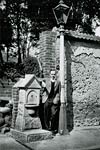 There was once a
public drinking
fountain by the wall, where St Andrews and Exwick Road
meet, opposite Station Road. It displayed the date 1887 and VR,
indicating it was installed for the Golden Jubilee of the illustrious
Queen, along with 1897, added for her Diamond Jubilee. A young
Dennis Hammond
is standing next to the fountain. There is a still a lamp post in that
position, but the wall has been rebuilt and as for the fountain
–
where
that has gone, no one knows, although for sure, it would have been
smashed to pieces, years ago, by the passing traffic if it had not been
removed.
There was once a
public drinking
fountain by the wall, where St Andrews and Exwick Road
meet, opposite Station Road. It displayed the date 1887 and VR,
indicating it was installed for the Golden Jubilee of the illustrious
Queen, along with 1897, added for her Diamond Jubilee. A young
Dennis Hammond
is standing next to the fountain. There is a still a lamp post in that
position, but the wall has been rebuilt and as for the fountain
–
where
that has gone, no one knows, although for sure, it would have been
smashed to pieces, years ago, by the passing traffic if it had not been
removed.
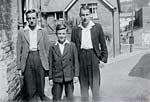 Kenneth, Leslie and Gordon
Scant at Exwick
Hill in 1947. Les Scant was brought to Exwick as a child in 1939. Here
he relates his memories of Exwick
at War.
Also see Tony Lethbridge's memories of a bomb
over Exwick.
Kenneth, Leslie and Gordon
Scant at Exwick
Hill in 1947. Les Scant was brought to Exwick as a child in 1939. Here
he relates his memories of Exwick
at War.
Also see Tony Lethbridge's memories of a bomb
over Exwick.
 Old
Bakery Close is on the site of the Hill, Palmer and Edwards 'Mothers
Pride' bakery. The bakery itself occupied the site of Delaney and
Gallay, a munitions factory that was sited there at the outbreak of
World War Two. The company manufactured aircraft parts, including the
Barracuda bomber, one of the aircraft types that was used in the action
to sink the Tirpitz battleship in a Norwegian fjord – so
Exwick
sank the Tirpitz! The management,
and
what looks like the office staff, pose for a photo sometime during the
war years.
Old
Bakery Close is on the site of the Hill, Palmer and Edwards 'Mothers
Pride' bakery. The bakery itself occupied the site of Delaney and
Gallay, a munitions factory that was sited there at the outbreak of
World War Two. The company manufactured aircraft parts, including the
Barracuda bomber, one of the aircraft types that was used in the action
to sink the Tirpitz battleship in a Norwegian fjord – so
Exwick
sank the Tirpitz! The management,
and
what looks like the office staff, pose for a photo sometime during the
war years.
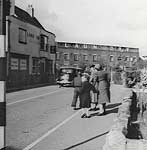 This
photograph was probably taken in the late 1940s. The Village Inn is
still called the Lamb, and the County Steam
Laundry behind, occupied a former fulling and paper mill. It was demolished in
1980.
This
photograph was probably taken in the late 1940s. The Village Inn is
still called the Lamb, and the County Steam
Laundry behind, occupied a former fulling and paper mill. It was demolished in
1980.
 Another
Coronation, another
celebration by the people of Exwick. Not nearly so formal as 1902, this
photograph was taken in 1953 for the Coronation of Queen Elizabeth II.
The social structure is more homogenised as more people own their own
homes, or live in housing provided by the railways or the City Council.
The old feudal system ended when the Buller's of Downes sold off most
of
their holdings in Exwick during
1922.
Another
Coronation, another
celebration by the people of Exwick. Not nearly so formal as 1902, this
photograph was taken in 1953 for the Coronation of Queen Elizabeth II.
The social structure is more homogenised as more people own their own
homes, or live in housing provided by the railways or the City Council.
The old feudal system ended when the Buller's of Downes sold off most
of
their holdings in Exwick during
1922.
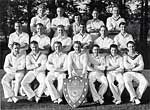 The cricket team
show off an
enormous shield sometime, I believe, in the 1960s. The pitch was behind
Mildmay Close, and the Health Centre. There was even a cricket
pavilion, but it was swept away in a flood.
The cricket team
show off an
enormous shield sometime, I believe, in the 1960s. The pitch was behind
Mildmay Close, and the Health Centre. There was even a cricket
pavilion, but it was swept away in a flood.
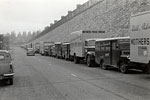 Twice
during 1960,
Exwick along with
St Thomas, and many other places in the Exe Valley, suffered severe
flooding. The bakery was flooded, causing the Hill Palmer and Edwards
delivery lorries and vans to park up along Exwick Road from Foxhayes
towards the cemetery. See Mike Ewing's memories of Exwick's floods.
Twice
during 1960,
Exwick along with
St Thomas, and many other places in the Exe Valley, suffered severe
flooding. The bakery was flooded, causing the Hill Palmer and Edwards
delivery lorries and vans to park up along Exwick Road from Foxhayes
towards the cemetery. See Mike Ewing's memories of Exwick's floods.
 The 1950s were a very
different time to
the early 21st century. Neighbours knew each other and there were more
Exwick events. Here a parade of children sometime in the 1950s walk
down St Andrews Road, with the County Steam Laundry behind, probably
for a carnival or church event.
The 1950s were a very
different time to
the early 21st century. Neighbours knew each other and there were more
Exwick events. Here a parade of children sometime in the 1950s walk
down St Andrews Road, with the County Steam Laundry behind, probably
for a carnival or church event.
 Also in the 1950s, more
children parade
past the post office.
Also in the 1950s, more
children parade
past the post office.
 It is thought that the
Boy's Brigade
were involved in this parade, also from the 50s. There are still some
living in Exwick who remember these events, and recognise themselves or
friends in the photos.
It is thought that the
Boy's Brigade
were involved in this parade, also from the 50s. There are still some
living in Exwick who remember these events, and recognise themselves or
friends in the photos.
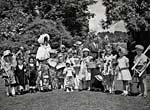 The village fete in 1966, was held in the vicarage gardens. The vicar at the time was the Rev. Michael C Boyes.
The village fete in 1966, was held in the vicarage gardens. The vicar at the time was the Rev. Michael C Boyes.
│ Top of Page │